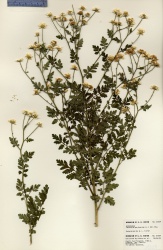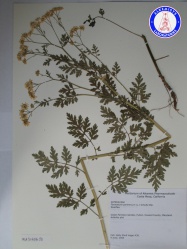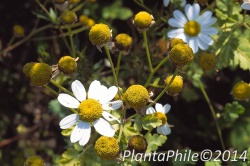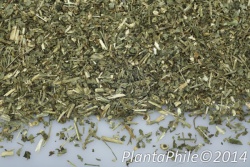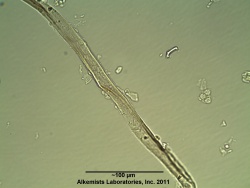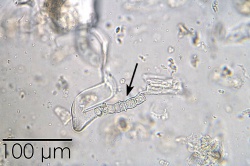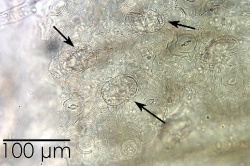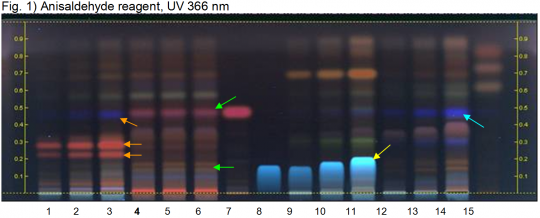Tanacetum parthenium (flower)
(add USD 1918 information (organoleptic and macroscopic)) |
|||
| (8 intermediate revisions by 3 users not shown) | |||
| Line 1: | Line 1: | ||
| − | = | + | {{DISPLAYTITLE: ''Tanacetum parthenium'' (flower) }} {{askbox|herb=''Tanacetum parthenium''}} |
| + | =Nomenclature= | ||
| − | = | + | {{nomenclature | binomial=Tanacetum parthenium |
| + | |authority=(L.) Sch. Bip. | ||
| + | |family=Asteraceae | ||
| + | |scn=feverfew | ||
| + | |syn=''Chrysanthemum parthenium'' (L.) Bernh. | ||
| + | |ayurvedic= | ||
| + | |pinyin= | ||
| + | |aka= | ||
| + | |notes= }} | ||
| + | |||
| + | =Botanical Voucher Specimen= | ||
| + | |||
| + | {{Media2 |cat=Voucher | ||
| + | |||
| + | | source=MOBOT, Tropicos.org | ||
| + | | mainimage=Tanacetum parthenium Tropicos 100018502.jpg | ||
| + | | companyimage=TropicosLogo.gif | ||
| + | | companyURL=http://www.tropicos.org/Image/100018502 | ||
| + | | reference=Tropicos.org. Missouri Botanical Garden. 21 Mar 2014 <http://www.tropicos.org/Image/100018502> | ||
| + | |||
| + | | source2=Botanical Voucher Specimen Library, Alkemists Laboratories | ||
| + | | image2=Tanacetum parthenium MA31406JD A0606.jpg | ||
| + | | companyimage2=AP-LOGO-Laboratories Crop - Copy.jpg | ||
| + | | companyURL2=http://www.alkemist.com | ||
| − | |||
| − | |||
| − | |||
| − | |||
| − | |||
| − | |||
| }} | | }} | ||
| − | = | + | =Organoleptic Characteristics= |
| + | {| border=1 | ||
| + | | | ||
| + | {{Organolepsy | source=United States Dispensatory (1918) | ||
| + | | description=[''Tanacetum parthenium''] has an odor and taste analogous to those of chamomile.}} | ||
| + | |} | ||
| + | =Macroscopic Characteristics= | ||
| + | {| border=1 | ||
| + | | | ||
| + | {{Macroscopy | source=United States Dispensatory (1918) | ||
| + | | description=A tall, perennial, branching herbaceous plant, with bipinnately divided leaves, the divisions being ovate, and compound flowers in a corymb. | ||
| − | {{Microscopy | source=Elan M. Sudberg, Alkemist Laboratories | + | [The flowers may be distinguished from] those of the true chamomile plant, ''Anthemis nobilis'', which they closely resemble, especially when double ... by their peculiar odor, their small receptacle, which is, moreover, rounded and flattened above, instead of being conical and somewhat pointed as in the ''Anthemis'', and by the tubular five-toothed central florets, which in the chamomile are small, few, and scarcely visible, but in the two former species are large, very numerous, and very long. |
| + | }} | ||
| + | |||
| + | {{Media2 |cat=Macroscopy | ||
| + | | source=PlantaPhile | ||
| + | | mainimage=PlantaPhile - 350.jpg | ||
| + | | companyimage=PlantaPhile logo.jpg | ||
| + | | companyURL=http://plantaphile.com/ | ||
| + | | | ||
| + | | source2=PlantaPhile | ||
| + | | image2=PlantaPhile_-_3056.jpg | ||
| + | | companyimage2=PlantaPhile logo.jpg | ||
| + | | companyURL2=http://plantaphile.com/ | ||
| + | | }} | ||
| + | |} | ||
| + | |||
| + | =Microscopic Characteristics= | ||
| + | |||
| + | {{Media3 |cat=Microscopy | source=Elan M. Sudberg, Alkemist Laboratories | ||
| companyimage= AP-LOGO-Laboratories Crop - Copy.jpg | | companyimage= AP-LOGO-Laboratories Crop - Copy.jpg | ||
| − | | companyURL=http://www. | + | | companyURL=http://www.alkemist.com |
| mainimage=Tanacetum - Alkemist Laboratories.jpg | | mainimage=Tanacetum - Alkemist Laboratories.jpg | ||
| caption3=Epidermis of leaf showing wavy anticlinal wall & short biseriate glandular trichomes observed at 400x with Acidified Chloral Hydrate Glycerol Solution. | | caption3=Epidermis of leaf showing wavy anticlinal wall & short biseriate glandular trichomes observed at 400x with Acidified Chloral Hydrate Glycerol Solution. | ||
| − | | | + | | source2=Elan M. Sudberg, Alkemist Laboratories |
| + | | companyimage2= AP-LOGO-Laboratories Crop - Copy.jpg | ||
| + | | companyURL2=http://www.alkemist.com | ||
| image2=Tanacetum-1 - Alkemist Laboratories.jpg | | image2=Tanacetum-1 - Alkemist Laboratories.jpg | ||
| caption2=Uniseriate covering trichome with numerous isodiametric basal cells and an elongated tapering end observed at 400x with Acidified Chloral Hydrate Glycerol Solution. | | caption2=Uniseriate covering trichome with numerous isodiametric basal cells and an elongated tapering end observed at 400x with Acidified Chloral Hydrate Glycerol Solution. | ||
| + | | source3=Elan M. Sudberg, Alkemist Laboratories | ||
| + | | companyimage3= AP-LOGO-Laboratories Crop - Copy.jpg | ||
| + | | companyURL3=http://www.alkemist.com | ||
| image3=Tanacetum-2 - Alkemist Laboratories.jpg | | image3=Tanacetum-2 - Alkemist Laboratories.jpg | ||
| caption1=Long slender terminal cell of a multicellular trichome observed at 400x with Acidified Chloral Hydrate Glycerol Solution. | | caption1=Long slender terminal cell of a multicellular trichome observed at 400x with Acidified Chloral Hydrate Glycerol Solution. | ||
| Line 26: | Line 77: | ||
| reference=British Pharmacopoeia, 2011 | | reference=British Pharmacopoeia, 2011 | ||
| }} | | }} | ||
| − | =HPTLC | + | =High Performance Thin Layer Chromatographic Identification= |
| + | {{HPTLC | source=HPTLC Association | ||
| + | | companyimage=HPTLC-assoc-Logo-farbig-Text-schwarz-300x47.png | ||
| + | | companyURL=http://www.hptlc-association.org/ | ||
| + | | mainimage=Tanacetum parthenium-Anisaldehyde reagent, UV 366 nm-hptlc-association.png | ||
| + | | caption1=Feverfew (flower) HPTLC ID - Anisaldehyde reagent, UV 366 nm | ||
| + | | description=Feverfew (flower) (''Tanacetum parthenium'') | ||
| + | | image2=Tanacetum parthenium-Anisaldehyde reagent, white RT-hptlc-association.png | ||
| + | | caption2=Feverfew (flower) HPTLC ID - Anisaldehyde reagent, white RT | ||
| + | | | ||
| + | | stationaryphase=Stationary phase, i.e. Silica gel 60, F254 | ||
| + | | mobilephase=Ethyl acetate, cyclohexane 1:1 (v/v) | ||
| + | | prep=Sample: Mix 1 g of powdered sample with 10 mL of methanol and sonicate for 10 minutes, then centrifuge or filter the solutions and use the supernatants / filtrates as test solutions. Dissolve 10 µL of the essential oil in 1 mL of toluene. | ||
| + | |||
| + | Derivatization reagent: Anisaldehyde reagent; Preparation: 170 mL of ice-cooled methanol are mixed with 20 mL of acetic acid, 10 mL of sulfuric acid and 1 mL of anisaldehyde; Use: Dip (time 0, speed 5), heat at 100°C for 4 min | ||
| + | | detection=Saturated chamber; developing distance 70 mm from lower edge; relative humidity 33% | ||
| + | | referencesamples=Reference: Dissolve 1.5 mg of apigenin in 5 mL of methanol. Dissolve 1 mg of parthenolide in 5 mL of methanol. | ||
| + | | | ||
| + | | lanes=Lanes, from left to right (Track, Volume, Sample): | ||
| + | # 1 µL Feverfew flower from Mexico | ||
| + | # 2 µL Feverfew flower from Mexico | ||
| + | # 4 µL Feverfew flower from Mexico | ||
| + | # '''3 µL Feverfew flower''' | ||
| + | # 3.5 µL Feverfew flower | ||
| + | # 4 µL Feverfew flower | ||
| + | # 2 µL Parthenolide | ||
| + | # 2 µL Apigenin | ||
| + | # 1 µL Roman Chamomile flower | ||
| + | # 2 µL Roman Chamomile flower | ||
| + | # 4 µL Roman Chamomile flower | ||
| + | # 1 µL Chamomile flower | ||
| + | # 2 µL Chamomile flower | ||
| + | # 4 µL Chamomile flower | ||
| + | # 1 µL Chamomile flower oil | ||
| + | |||
| + | | notes=''Images presented in this entry are examples and are not intended to be used as basis for setting specifications for quality control purposes.'' | ||
| + | |||
| + | System suitability test: (UV 366 nm); Apigenin: blue zone at Rf ~ 0.20; Parthenolide: pink zone at Rf ~ 0.48 | ||
| + | |||
| + | Identification: Compare result with reference images. The fingerprint of the test solution is similar to that of the corresponding botanical reference sample. Additional weak zones may be present. Under UV 366 nm the chromatogram of the test solution shows a prominent pink zone (violet zone under white light) at Rf ~ 0.48 corresponding to reference substance parthenolide. Above it there is a greenish zone (grey zone under white light) and a weak brownish zone (violet zone under white light). At the position of reference substance apigenin (Rf ~ 0.20) there are two brown zones (grey zone under white light) (green arrows). | ||
| + | |||
| + | Test for adulteration: Under UV 366 nm there are no intense red zones (violet zone under white light) between Rf ~ 0.20 and 0.30. No blue zone is seen at the position of parthenolide (orange arrows; Feverfew flower from Mexico). Under UV 366 nm no blue zone at the position of apigenin (Rf ~ 0.20) is seen (yellow arrow; Roman Chamomile flower). Under UV 366 nm no blue zone is seen at the position of parthenolide (blue arrow; Chamomile flower). Chamomile flower oil does not show any zones below Rf ~ 0.60. | ||
| + | |||
| + | |||
| + | | }} | ||
| − | = | + | =Supplementary Information= |
| − | + | =Sources= | |
| + | <references /> | ||
Latest revision as of 20:51, 21 April 2015
Contents |
Nomenclature
Tanacetum parthenium (L.) Sch. Bip. Asteraceae
Syn. Chrysanthemum parthenium (L.) Bernh.
Standardized common name (English): feverfew
Botanical Voucher Specimen
 |
|
|
|
|
Organoleptic Characteristics
|
Macroscopic Characteristics
|
Microscopic Characteristics
 |
 |
 |
|
|
|
|
High Performance Thin Layer Chromatographic Identification
|
Feverfew (flower) (Tanacetum parthenium) Lane Assignments Lanes, from left to right (Track, Volume, Sample):
Reference Sample(s) Reference: Dissolve 1.5 mg of apigenin in 5 mL of methanol. Dissolve 1 mg of parthenolide in 5 mL of methanol. Stationary Phase Stationary phase, i.e. Silica gel 60, F254 Mobile Phase Ethyl acetate, cyclohexane 1:1 (v/v) Sample Preparation Method Sample: Mix 1 g of powdered sample with 10 mL of methanol and sonicate for 10 minutes, then centrifuge or filter the solutions and use the supernatants / filtrates as test solutions. Dissolve 10 µL of the essential oil in 1 mL of toluene. Derivatization reagent: Anisaldehyde reagent; Preparation: 170 mL of ice-cooled methanol are mixed with 20 mL of acetic acid, 10 mL of sulfuric acid and 1 mL of anisaldehyde; Use: Dip (time 0, speed 5), heat at 100°C for 4 min Detection Method Saturated chamber; developing distance 70 mm from lower edge; relative humidity 33% Other Notes Images presented in this entry are examples and are not intended to be used as basis for setting specifications for quality control purposes. System suitability test: (UV 366 nm); Apigenin: blue zone at Rf ~ 0.20; Parthenolide: pink zone at Rf ~ 0.48 Identification: Compare result with reference images. The fingerprint of the test solution is similar to that of the corresponding botanical reference sample. Additional weak zones may be present. Under UV 366 nm the chromatogram of the test solution shows a prominent pink zone (violet zone under white light) at Rf ~ 0.48 corresponding to reference substance parthenolide. Above it there is a greenish zone (grey zone under white light) and a weak brownish zone (violet zone under white light). At the position of reference substance apigenin (Rf ~ 0.20) there are two brown zones (grey zone under white light) (green arrows). Test for adulteration: Under UV 366 nm there are no intense red zones (violet zone under white light) between Rf ~ 0.20 and 0.30. No blue zone is seen at the position of parthenolide (orange arrows; Feverfew flower from Mexico). Under UV 366 nm no blue zone at the position of apigenin (Rf ~ 0.20) is seen (yellow arrow; Roman Chamomile flower). Under UV 366 nm no blue zone is seen at the position of parthenolide (blue arrow; Chamomile flower). Chamomile flower oil does not show any zones below Rf ~ 0.60. Source: HPTLC Association [10] |
Supplementary Information
Sources
- ↑ MOBOT, Tropicos.org http://www.tropicos.org/Image/100018502
- ↑ Botanical Voucher Specimen Library, Alkemists Laboratories http://www.alkemist.com
- ↑ United States Dispensatory (1918)
- ↑ United States Dispensatory (1918)
- ↑ PlantaPhile http://plantaphile.com/
- ↑ PlantaPhile http://plantaphile.com/
- ↑ Elan M. Sudberg, Alkemist Laboratories http://www.alkemist.com
- ↑ Elan M. Sudberg, Alkemist Laboratories http://www.alkemist.com
- ↑ Elan M. Sudberg, Alkemist Laboratories http://www.alkemist.com
- ↑ HPTLC Association http://www.hptlc-association.org/
